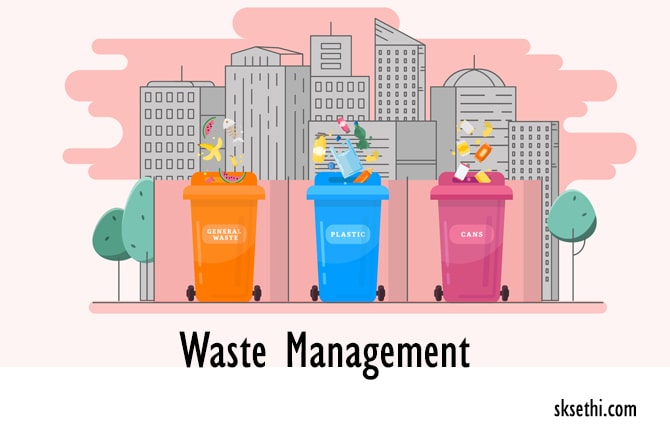what is waste management ?
Water is most essential for life on earth. No known organism can live without it. Being a precious resource of nature, it should not contaminated, polluted and wasted for any reason. However, for centuries, water bodies has been used as a dumping ground for human sewage and industrial wastes.
Dirty waters or waste waters can be classified by their, origin as domestic waste water and industrial waste water. Any combination of waste water that is collected in municipal sewers is termed as municipal sewage. Municipal sewage is conducted outside the city/town/metropolitan by open or closed drainage. Domestic waste water is that which is discharged from residential and commercial establishments.
The pollutants in domestic waste water arise from residential and commercial cleaning operations, laundry, food preparation, body cleaning functions and body excretions (i.e., urine and faeces). Normally, wastewaters are conducted to treatment plants for removing undesirable components which include both organic and inorganic matter as well as soluble and insolub e material. These pollutants, if discharged directly or with improper treatment, can interfere with the se fcleaning mechanisms of water bodies such as the Ganga river.
The capacity for self-cleaning is due to the presence of relatively small numbers of different types of micro-organisms in the water bodies. These micro-organisms, use as food, much of the organic pollutant and break them down into simple components such as carbon dioxide and methane, and micro-organisms produce new cells also.
But often, either a pollutant does not degrade naturally or the sheer volume of the pollutant discharged is sufficient to overwhelm the self-cleaning process. Also, the microbial population can be destroyed by toxic wastes build-up and reach levels that would be high enough to prevent re-establishment of a microbial population. The water quality of a water body, thus, becomes permanently degraded.
Waste Management
What does waste water contain ?
The waste water from your home contains used water made up of soap, food particles, toothpaste, bits of paper, strands of hair, traces of oil, dust, urine and human excreta. During monsoons, rainwater also gets into the drains and adds silt, pebbles, leaves and other plant materials to the waste water. The waste water flowing through the
drainage pipes is called sewage.

How does sewage water harm aquatic life?
Household sewage contains organic waste materials like human excreta, urine and food particles. These wastes provide nutrients for microorganisms. If sewage water is released into a lake or river, micro-organisms like bacteria, fungi and algae grow in large numbers. These organisms obtain nutrients by decomposing organic waste. To decompose waste, micro-organisms use oxygen dissolved in water.

A large population of micro-organisms in a ‘water body would decrease the amount of dissolved oxygen in the water. They would also block sunlight due to which aquatic plants cannot photosynthesise. Death of aquatic plants further reduces the amount of oxygen in the water.
Most aquatic animals use oxygen dissolved in the water to live. Once the level of dissolved oxygen falls, fish and most other’ aquatic animals also begin to die.
Every city and town produces a huge amount of sewage. Can we let sewage water directly flow into rivers and oceans? If sewage water is allowed to directly flow into water bodies, it would pollute these sources. Such water from lakes and rivers will not be suitable for human consumption or for growing crops. It will also harm all kinds of plants and animals living in these waters.
WHAT YOU SHOULD DO TO CONTROL SEWAGE :
Following are a few measures that you can adopt to control generation of sewage:
- Use flushes with low capacity.
- Never pour household products such as cleansers, ; beauty products, medicine, automobile oil, and paint down the drain. . These, contain chemicals which the wastewater treatment plants may not be able to remove. These should be properly disposed.
- Excess cooking oil, butter, Jor wastage meat fats, and plastic should be disposed off in the garbage can. These materials can clog pipes, and could cause sewage to overflow in your home or in public areas.
- Fix leakages in your sewer pipes. You will not want sewage to contaminate your drinking water, will you? It can also flow into your yard and be the breeding place of disease-causing insects such as flies, cockroaches, and mosquitoes.
A city or a town produces millions of litres of waste water everyday. You have learnt that only 2 per cent of the total water on the surface of the earth is freshwater. When freshwater is scarce, such huge amounts of water cannot be wasted. The water that flows through the drains is taken to a sewage treatment plant, where it is cleaned. This water can be used for various purposes.
How is waste water treated in a sewage treatment plant ?
Waste water is treated using a series of physical and chemical treatments.
Removal of large solids from the sewage

The sewage reaches a sewage treatment plant through a network of pipes. The waste water is made to pass through screens which separate solids such as pieces of stones, wood, plastics, glass and metal.
Sedimentation of waste from water
After passing the waste water through the screens, it is transferred to large tanks where it is allowed to settle for 8-12 hours. During this period, most of the organic waste such as human excreta settles at the bottom of the tank. This type of waste is called sludge. Sludge is a watery mixture of organic waste.
The sludge from the settlement tank is shifted to another tank called the digester where it is converted into manure or burnt and used as landfill.
Decomposition of organic matter
After separating the sludge from the sewage, the waste water is transferred into large tanks where air along with micro-organisms is bubbled into the tank. The waste water is held in the aerated tanks for 48 hours.
During this period, the micro-organisms decompose most of the organic matter still present in the sewage. Decomposition breaks down waste matter into harmless substances. Oxygen in the air is used by the micro-organisms to respire.
Final separation of sediments and chemical treatment
Now the waste water is transferred to a large tank where the decomposed waste settles at the bottom. These tanks too are called sedimentation tanks. After allowing enough time for the solids to settle, the waste water is drained out from the tanks. At this stage, most of the solid substances from the water are removed.
The water is then shifted to a tank where it is treated with chlorine to kill all the microorganisms present in the waste water. The dirty water that was brought to the sewage treatment plant is now absolutely clean and can be used to cultivate crops, maintain large gardens and manufacture goods in industries.
The water can also be discharged into oceans, rivers and lakes or used to recharge groundwater.
Septic tank: An alternate arrangement for sewage disposal
Many villages in our country are still not connected to a common sewage treatment plant. In such places, a septic tank is used to treat household sewage. A large concrete tank is built under the ground with inlet and outlet pipes attached to it. The inlet pipe carries the household sewage to the tank. The solid matter from the sewage settles at the bottom of the tank. Bacteria present in the tank decompose
CHEMICAL TOILETS
A chemical toilet uses chemicals to disinfect the waste. These toilets are most commonly found in aircrafts. A simple chemical toilet consists of a seat on a container with a solution of chemicals used to disinfect and deodorise the waste.
Lack of sanitation can spread diseases
Many people in our country do not have access to sanitation facilities. They use open places such as ailway tracks, fields, dry river beds and
the solid waste. The excess water flows out of the tank through the outlet pipe into the soil. The decomposed solid matter must be removed from the tank periodically.
A septic tank, is an onsite mini sewage treatment plant. It is suitable for places having sandy soil, as the outlet pipe gets blocked in clayey soil. A cluster of four to five houses can install and maintain a common septic tank. With a few modifications, a septic tank can be converted into an efficient biogas plant.
playgrounds to defecate. Human excreta left on the land can contaminate water sources like rivers, lakes, ponds and even groundwater. The contamination can cause water-borne diseases such as cholera, typhoid, hepatitis and dysentery.
In some towns and cities, there are open drainage systems. An open drainage system is a health hazard. It is not only a breeding place for ‘ mosquitoes and flies but also spreads water-borne diseases and contaminates water sources during monsoons.






